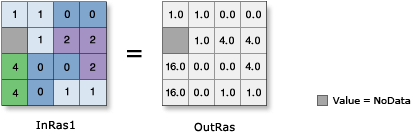Mit der Spatial Analyst-Lizenz verfügbar.
Mit der Image Analyst-Lizenz verfügbar.
Zusammenfassung
Raises the cell values in a raster to the power of the values found in another raster.
Abbildung

Auswertung
Bei Verwendung eines Operators mit einem Eingabe-Raster ist das Ergebnis ein Raster. Wenn jedoch alle Eingaben Zahlen sind, dann ist das Ergebnis ebenfalls eine Zahl.
Wenn in einem Ausdruck mehrere Operatoren verwendet werden, werden sie nicht zwingend von links nach rechts ausgeführt. Vielmehr wird der Operator mit dem höchsten Vorrangswert zuerst ausgeführt. Weitere Informationen zur Operatorrangfolge finden Sie in der Operatorrangfolgentabelle. Sie können die Reihenfolge der Ausführung jedoch mithilfe von Klammern steuern.
Output values are always floating point, regardless of the input value type.
Another way to perform the power operation is a **= b, which is an alternative way to write a = a ** b.
Wenn beide Eingaben Einzelband-Raster sind oder wenn eine der Eingaben eine Konstante ist, dann ist die Ausgabe ein Einzelband-Raster.
Wenn beide Eingaben Multiband-Raster sind oder wenn eine der Eingaben eine Konstante ist, dann ist die Ausgabe ein Multiband-Raster. Die Anzahl an Bändern in jeder Multiband-Eingabe muss identisch sein.
Der Operator führt den Vorgang für jedes Band aus einer Eingabe mit dem entsprechenden Band aus der anderen Eingabe durch. Wenn eine der Eingaben ein Multiband-Raster und die andere Eingabe eine Konstante ist, führt der Operator den Vorgang für jedes Band in der Multiband-Eingabe mit dem konstanten Wert durch.
Syntax
in_raster_or_constant1 ** in_raster_or_constant2
| Operand | Erklärung | Datentyp |
in_raster_or_constant1 | The input values to be raised to the power defined by the second input. If the first input is a raster and the second is a scalar, an output raster is created with each input raster value being raised to the power of the scalar value. | Raster Layer | Constant |
in_raster_or_constant2 | The input that determines the power to which the values in the first input will be raised. If the first input is a scalar and the second is a raster, an output raster is created with the scalar value being raised to the power of each input raster value. | Raster Layer | Constant |
Rückgabewert
| Name | Erklärung | Datentyp |
| out_raster | Das Ausgabe-Raster-Objekt. The cell values are the result of raising the values in the first input to the power of the values in the second input. | Raster |
Codebeispiel
This sample uses the values in the second input raster as the power by which to raise the values in the first input raster.
import arcpy
from arcpy import env
from arcpy.ia import *
env.workspace = "C:/iapyexamples/data"
outPower = Raster("degs") ** Raster("cost")
outPower.save("C:/iapyexamples/output/outpower.img")This sample uses the values in the second input raster as the power by which to raise the values in the first input raster.
# Name: Op_Power_Ex_02.py
# Description: Raises the cells in a raster to the power of the values
# found in another raster
# Requirements: Image Analyst Extension
# Import system modules
import arcpy
from arcpy import env
from arcpy.ia import *
# Set environment settings
env.workspace = "C:/iapyexamples/data"
# Set local variables
inRaster1 = Raster("degs")
inRaster2 = Raster("cost")
# Execute Power
outPower = inRaster1 ** inRaster2
# Save the output
outPower.save("C:/iapyexamples/output/outpower")